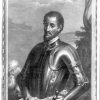calsfoundation@cals.org
Pacaha (?–?)
Pacaha was a Native American chief who lived in northeastern Arkansas during the 1500s. He is known solely from the four written accounts of the Hernando de Soto expedition, which passed through the region in the summer of 1541. One of the accounts refers to him as Capaha, but this is probably an author’s or editor’s mistake.
Pacaha lived in a fortified village near the Mississippi River. The town was surrounded by a water-filled moat and a log palisade wall, with guard towers along the wall. Archaeologists speculate that the town may have been in what is now Crittenden County.
When Hernando de Soto arrived, Pacaha was at war with a nearby chief named Casqui. Both chiefs ruled over several smaller towns and villages. This war had been going on a long time, possibly for generations, with no end in sight. De Soto managed to establish a fragile peace between the two, but it probably did not last after he left the region.
When the de Soto expedition arrived in Arkansas, Casqui was the first chief with whom it made contact. After a few days, the expedition traveled to meet Pacaha, and many of Casqui’s people followed. Assuming that an attack was underway, Pacaha and the residents of his town fled to an island or a better-fortified village nearby. Casqui’s people took the opportunity to sack the town, looting and destroying much of it. After a brief battle, de Soto convinced Pacaha that his intentions were peaceful and prevented him from launching a retaliatory attack on Casqui. In turn, he persuaded Casqui to apologize and to return stolen items to Pacaha. A special dinner was held, at which de Soto formalized peace between the rival leaders. Pacaha presented de Soto with three women: one of his wives, one of his sisters, and another woman from the tribe. This was partly to upstage Casqui, who had given one of his daughters to de Soto. These “marriages” were meant to establish a lasting alliance between each chief and de Soto.
The de Soto expedition remained at Pacaha’s town for forty days, during which exploratory parties were sent to the north to continue searching for gold and to help decide which direction to travel next. Unfortunately, the Spanish accounts do not relate much about events at Pacaha’s town during this time, nor do they provide more information about Pacaha himself. No other written records exist, so it remains unknown as to what befell Pacaha after the de Soto expedition proceeded farther into Arkansas.
For additional information:
Clayton, Lawrence A., Vernon James Knight Jr., and Edward C. Moore, eds. The De Soto Chronicles: The Expedition of Hernando de Soto to North America in 1539–1543. 2 vols. Tuscaloosa: University of Alabama Press, 1993.
Hudson, Charles. Knights of Spain, Warriors of the Sun: Hernando de Soto and the South’s Ancient Chiefdoms. Athens: University of Georgia Press, 1997.
Williams, Nancy A., ed. Arkansas Biography: A Collection of Notable Lives. Fayetteville: University of Arkansas Press, 2000.
Jeffrey M. Mitchem
Arkansas Archeological Survey
This entry, originally published in Arkansas Biography: A Collection of Notable Lives, appears in the CALS Encyclopedia of Arkansas in an altered form. Arkansas Biography is available from the University of Arkansas Press.
 European Exploration and Settlement, 1541 through 1802
European Exploration and Settlement, 1541 through 1802 Politics and Government
Politics and Government



I am 100 and 100% in believing that I know where some of Hernando de Soto’s Spaniards lie in the ground. One mile west of Fort Smith, Arkansas, there is a graveyard that goes way back, but I as a boy found a stone cold with 1540 on it and I have yet to get help to save this before it is plowed under. I have contacted Oklahoma and several others, but they just don’t believe that it’s plausible but it is.